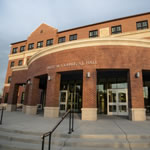“Sustainability is the critical part of the Jesuit Catholic mission,” says Michael Redmond, the associate vice president of physical plant and capital projects at Regis University, which in December 2012 completed construction on Clarke Hall, one of the most energy-efficient buildings in the Rocky Mountain Region. “We want to be leaders in our region for others to follow. Incoming students are keenly aware of what we do in the sustainable area—it is part of our recruitment process.”
Clarke Hall was designed to house the College of Professional Studies, the university brand marketing offices, a university-wide learning commons, distance learning design, and state-of-the art meeting and seminar rooms for the Denver university. The cradle-to-grave, 82,000-square-foot, four-story project started with design in fall 2010 and was dedicated in January, and it’s currently in its warranty period. Although the school chose not seek LEED certification, LEED criteria and strategies were used as guidelines to make the building more energy efficient.
“Incoming students are keenly aware of what we do in the sustainable area—it is part of our recruitment process.”
Michael Redmond, Regis University
Regis hired Soderstrom Architects of Portland, Oregon, to design the building because of the firm’s known sustainability-focused approach and because of Regis’ history with the architects—the architecture firm has designed six other projects for the university. “Their fast-track, cradle-to-grave process for design is phenomenal,” Redmond says. “Our buildings are a mix of gothic and other types of construction. The whole campus aesthetically matches—[Soderstrom] was excellent at that.” Some of Clarke Hall’s green features include an evaporative cooling system, daylight harvesting, night-flush mechanical cooling, sustainable carpet tile flooring, touchless restrooms, radiant floor-heating, solar-heated domestic water system, window sensors, a 75-year concrete tile roof, and low-E insulated windows.
One of the biggest energy savers for the building is the window-sensor control system. The localized HVAC dampers are automatically shut off in the areas where windows are opened, but the system continues to cool other areas of the building. This saves energy and dollars and reduces wasteful air-conditioning throughout the building.
Night-flush mechanical cooling is used between June and September when temperatures are at their optimal levels in the Denver climate. The process takes the building down to a core temperature between 50 and 55 degrees, and then it brings in all fresh air. “During the daytime when you cycle air, 50 to 60 percent of the air is recirculated in the building,” Redmond says. “At night, it is completely flushed out. We have a computerized energy management system that reestablishes the temperatures of the building in the morning before the first classrooms and offices are used. It enhances the building’s performance. People talk about stale air, and this is what night flushing is all about.”
Cutting back on electrical needs was a crucial component of the energy modeling done by Xcel Energy, and Regis used LED lighting and enhanced lighting systems to keep energy use low. “[The energy model] required us to have certain points to save money when it came to the performance of the building,” Redmond says. “The square footage versus the cost of our utilities in the building was $111,000 dollars per year. When we energy modeled it, we were able to get the cost down to $55,000 a year. The benefit of our sustainable design and life-cycle payback was critical in the electrical areas.” Hard costs for the project were $14.6 million at $197 per square foot. After added amenities, equipment, furnishings, and electronics after construction, the cost totaled $18.4 million.

